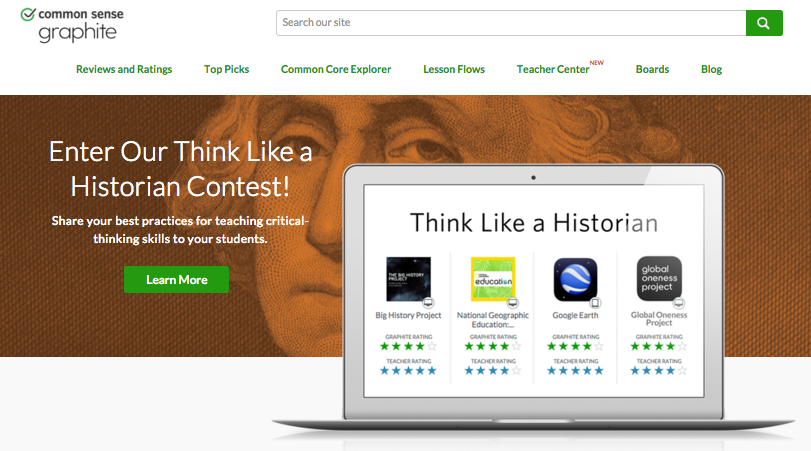We recently released Getting a Read on the App Stores: A Market Scan and Analysis of Children’s Literacy Apps, in which we discuss the challenges facing parents and educators who are looking for quality literacy apps for young children. We invited our colleagues at Common Sense Media—whom we cite as an expert source of reliable app reviews for parents—to tell us more about Graphite, which aims to help educators find high quality apps for students by criteria such as platform, subject areas, grade levels, and skills.
From an app to an overheard projector, from a paperweight to a pencil: any tool is tech. But that’s not how everyone sees it. In the hyper-competitive, boom or bust, move fast world of edtech evangelism and the startup culture within which its embedded, tech is now and apps are the great equalizers. Each new tool changes everything. All apps solve some long lingering problem. Every product launch brings light to the darkness and balance to the force. And if you think I’m being dramatic, you need to start checking out some startup websites and promotional videos.
That’s not to say there isn’t cool stuff happening in edtech (or tech more broadly). There is, and it’s exciting. The problem is that if you’re an active teacher or administrator looking to make a purchase for your school or district, it’s tough to separate signal from noise or substance from sales pitch. You can talk to colleagues, but they’re also way too busy to find everything and give it a good look. There’s Google, of course, and the various app stores and aggregators, but how do you make sense of tens of thousands to millions of results influenced by just about everything but what works best for teachers?
This was the main problem we built Common Sense Graphite to solve: sorting through edtech and elevating the best of the best. We’re a non-profit and completely free to use with no biases or strings attached, and most of the editorial staff has spent time in classrooms (or still is!). We pride ourselves on offering some refreshing real talk and a trustworthy take.
It’s been over two years now, and we’ve been tirelessly reviewing, rating, categorizing, and curating edtech. We’ve also been cultivating a community of active teachers who do the same. We’ve now got thousands of reviews and teacher-curated boards as well as a couple hundred best-of lists curated and updated by our editors.
Our editorial reviews, if I can brag a little, are unlike anything else out there: they’re in-depth (but still easy to skim), backed by a rubric aligned to the latest research on learning design, and designed from the ground up to give teachers the information they need. Every review is evaluated by at least two staff members who are some of the most knowledgeable people about edtech in the country. Better yet: after the review is published our community of tens of thousands of teachers get to weigh in—providing a nice balance of unbiased editorial evaluation and on-the-ground perspective.
For us, success has been getting a teacher to stop in and quickly find something awesome and inspiring to use in his/her classroom the next day. What we’ve realized though is that this takes more than just reviews and lists of tools. Why? Because tech is tech; a tool alone will never transform a classroom. Transformation is what teachers do—not tools; it’s a simple thing, really, but something the edtech world too-often ignores in favor of technological solutionism.
As we further evolve Graphite, what we’re trying to do is better connect the dots between great teachers, tools, and teaching practice—presenting opportunities for inventive teachers to use tech in ways that expand the possibility space in a classroom.
Wrangling tech and using it effectively isn’t easy though. Tools aren’t always tuned to the realities of classrooms let alone promoting effective and innovative pedagogical approaches. Far from reinventing (dare I say “disrupting”) teaching or pushing boundaries, a lot of edtech looks awfully similar to business as usual and can easily be used in classrooms to just tread water. Out of the over 2,000 tools we’ve reviewed at Graphite, less than 10% have received our five-star rating and even fewer get five stars from both our editorial team and teacher community.
What has been especially exciting is seeing developers respond to our reviews. While teachers are Graphite’s main audience, and we set up a very clear firewall between our editorial staff and developers, we want to communicate and collaborate with developers through our reviews. The way we see it: we’re all in this thing together. Our hope is that we give developers fair, substantive feedback that can help them iterate. We’ve seen some evidence of this happening. Since our reviews are “living” and get regularly updated, we’ve watched as a good share of tools’ ratings gradually climb with each updated review. We’ve also seen an increasing amount of developers with classroom experience, or a dedication to working closely with teachers and schools to pilot their products.
The most exciting thing of all though is getting surprised by teachers with creative, unexpected uses for tools. On Graphite, teachers can take tools and structure them in a lesson plan creation tool, sharing their best practices and activities with others. We didn’t promote this functionality much initially, but it exploded in popularity. Teachers, especially the bleeding edge innovators who were Graphite’s core user base, were excited to share the stuff that had been working for them. What we noticed was that many of these lessons featured tools we liked but didn’t quite love. That didn’t matter though, because teachers made them shine anyway. That’s what’s really special about teachers: they can make any tool great. They’ve been doing it with everything from post-its to blackboards for decades.
This brings me to what’s fundamentally wrong with much of the Silicon Valley-fueled discussion about technology and learning. It’s too often thought of as a kind of science and if you just get the right tool and teach it in the right way then you’ll get the right result. But teachers aren’t scientists or technicians, they’re artists. They improvise, tinker, and create. They make experiences that change how students see the world. Art isn’t exact; it’s messy and weird. It doesn’t always go as planned, and not everyone gets it. And while technology shapes art (always has, always will), technology, in an artist/teacher’s hands, will always be one step behind her.
 Tanner Higgin is Senior Manager of Education Content at Common Sense Education. His focus is on Graphite.org where he serves as staff expert on game-based learning and guides the editorial direction for arts and teacher tools. He’s also the editorial team’s content strategist and product development liaison. Previously, he taught writing and media literacy for six years, and has a PhD from the University of California, Riverside. His research on video games and culture has been published in journals, books, and online, presented at conferences nationwide, and continues to be cited in research and taught in classes around the world.
Tanner Higgin is Senior Manager of Education Content at Common Sense Education. His focus is on Graphite.org where he serves as staff expert on game-based learning and guides the editorial direction for arts and teacher tools. He’s also the editorial team’s content strategist and product development liaison. Previously, he taught writing and media literacy for six years, and has a PhD from the University of California, Riverside. His research on video games and culture has been published in journals, books, and online, presented at conferences nationwide, and continues to be cited in research and taught in classes around the world.




